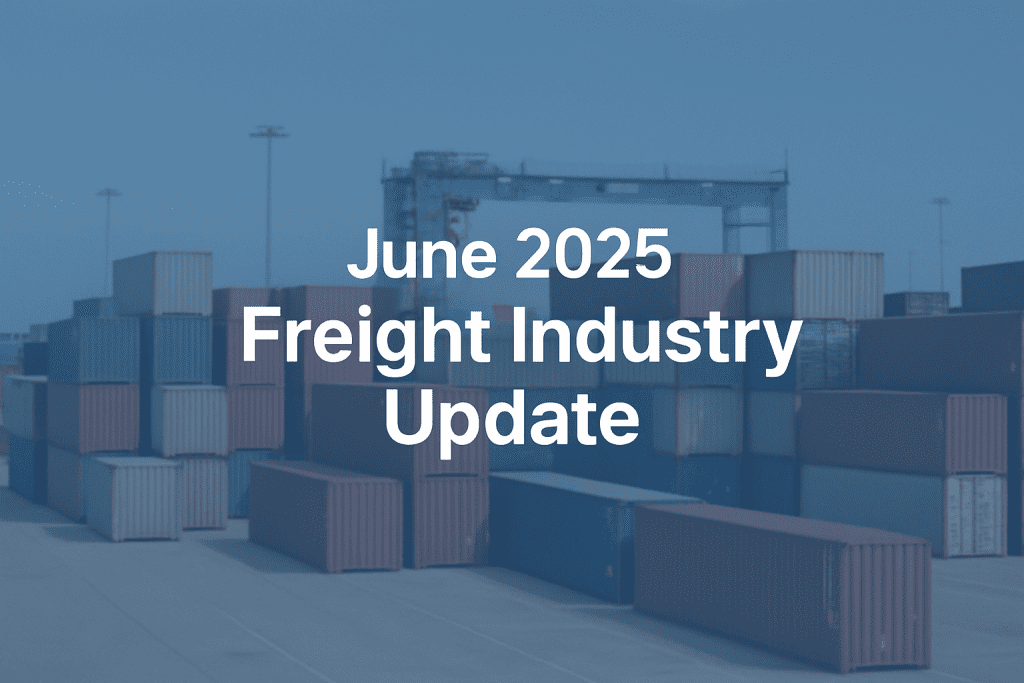June 2025 Freight Industry Update: What’s Moving the Market
As we step into June, the freight industry is feeling the pressure from a mix of economic, seasonal, and technological shifts. The transportation landscape is evolving rapidly, and staying informed is critical for shippers, carriers, and supply chain professionals. Below, we break down the most important stories and what they mean for your logistics strategy in the coming months.
1. Tariff Turbulence Resurfaces
The Trump administration’s reimplementation of tariffs has reawakened global trade tensions. According to The Wall Street Journal, logistics costs have increased by 5.4%, climbing to nearly $2.6 trillion. Retailers like Target are now looking to diversify sourcing as they brace for higher transportation and customs expenses.
These tariff adjustments not only influence the price of imported goods but also force companies to reassess global supply chain structures. Some shippers are accelerating nearshoring strategies to reduce their exposure to international volatility. This is a critical time to assess your landed cost models and update your TMS parameters accordingly.
Source: The Wall Street Journal
2. Seasonal Surge in Freight Demand
June signals the start of harvest season across the southern U.S., which increases demand for both dry van and refrigerated capacity. Add in the annual "moving season," and capacity tightens quickly, pushing rates upward. This is a key moment for shippers to evaluate route efficiency and carrier performance.
Spot market volatility tends to follow seasonal trends, and this year is no different. Agricultural demand spikes often ripple into other verticals, creating lane imbalances that can complicate inbound freight schedules. If you haven’t reviewed your routing guides or carrier compliance KPIs recently, now is the time.
Source: ATS Inc.
3. Autonomous Trucks Hit the Road
Aurora Innovation is gaining traction in the autonomous freight space, recently logging 1,200+ miles of fully driverless trucking on Texas highways. The move highlights growing investment in automation to address labor shortages and improve long-haul efficiency.
While full autonomy may still be years from widespread adoption, incremental advances like this one signal growing confidence among early adopters. For logistics leaders, the takeaway is clear: keep an eye on pilot programs and state by state regulatory shifts that may open up new opportunities for automation.
Source: New York Post
4. Smart Infrastructure Near U.S. Ports
To ease congestion near one of the East Coast’s busiest ports, Cavnue is building a smart freight corridor in Savannah, Georgia. The project will include real-time data systems designed to streamline traffic flow and reduce costly delays.
This initiative reflects a broader push toward digitizing infrastructure. Real-time feedback loops between roadways and vehicles can increase throughput and safety, two top priorities for time sensitive shipments. It also raises important questions about how public and private stakeholders can share data effectively.
Source: Axios
5. Ocean Freight Faces New Pressure
Ocean shipping costs have jumped by up to 200% year to date. Red Sea instability, new tariffs, and carrier surcharges are behind the spike. Import heavy industries, including solar and consumer electronics, are especially impacted.
With capacity being rerouted and rates climbing, shippers should revisit their Incoterms, review backup port options, and revalidate inventory buffers. Forwarders and brokers play a crucial role right now in helping clients navigate this volatile environment.
Source: Eco Green Energy
6. Uber Freight Uses AI to Cut Waste
Uber Freight is using AI to optimize truck routes and reduce empty miles. The result? A reported 10 to 15% reduction in deadhead miles. That means lower emissions, fewer wasted hours, and tighter cost control for shippers.
The logistics industry has long chased this holy grail: minimize inefficiency while increasing flexibility. AI may finally be delivering on that promise. Companies should begin considering how similar tools can be layered into their own TMS workflows, especially if they're managing a hybrid network of dedicated and spot carriers.
Source: Business Insider
At Hatfield & Associates, we help shippers stay ahead of these changes through smarter transportation management , carrier compliance tracking, and freight audit services. If your team is feeling the impact of seasonal constraints, volatile tariffs, or rising costs, let’s connect. We’ll show you how our tools and services can provide actionable data and cost control.
Stay tuned for our July update as we continue monitoring these and other fast moving trends in logistics.




